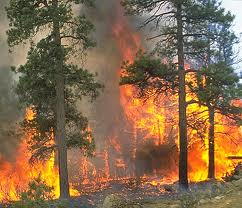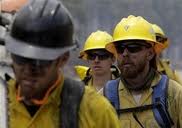A commentary by Dr. Frances Levine, director of the New Mexico History Museum.
Four times in my New Mexico life I’ve smelled the acrid smoke, scanned the roiling skies, and waited anxiously for summer monsoons to quell fires on the Pajarito Plateau. The first time—the summer of 1977—seared my deepest memories of the damage wildfires can do and how dangerous and strategic the work of fire crews must be.
That was my second summer as a full-time resident of New Mexico, and I was still getting used to the idea that we could bake in the desert sun during the day, and shiver with the chill of the mountain air at night. I had moved from Dallas, where we just sweated by day and sweltered by night.
Working for the National Park Service as an archaeologist, I was learning how to be a professional cultural resources manager. The fields of archaeology, public history and historic preservation were just beginning to be a part of land-use planning. We consulted with Native American and Hispanic communities and planned projects with range conservationists and wildlife biologists. We formed teams to protect endangered species and to plan highways and development projects—all in the name of protecting New Mexico’s natural and cultural resources.
Then came the call that would forever change the way I thought about our place in the natural world.
 On June 16, 1977, a huge fire broke out in Bandelier National Monument. Because of our team-planning sessions, we knew how to work together on paper. Now came the opportunity to assist in a real-world situation, where fire wasn’t just threatening the landscape but precious remnants of a much earlier culture.
On June 16, 1977, a huge fire broke out in Bandelier National Monument. Because of our team-planning sessions, we knew how to work together on paper. Now came the opportunity to assist in a real-world situation, where fire wasn’t just threatening the landscape but precious remnants of a much earlier culture.
I was one of more than 40 archaeologists called in to walk in front of the bulldozers and work side-by-side with the teams digging firebreaks to steer them away from room blocks and the many other sensitive sites that dot the parkland. It was the closest I had ever come to understanding warfare as I walked next to firefighters who battled the flames with hand tools and cleared brush to create fire breaks.
I can’t forget the sound and the sight of the winds driving embers through burning trees, the orange glow in the forest, the thick black smoke, and the feeling that someone or something menacing was behind us, chasing us to the point of exhaustion.
At the end of each day, standing in line at fire camp to receive our bag lunches, we were too parched to talk, too dirty to tell one person from another, and too exhausted to socialize much. But we had a shared sense of purpose, a measurable accomplishment on most days, and a sense of teamwork that inspires me still.
 Since then, whenever I hear of a fire, I think of the fire crews. I think about them being pursued by what author Norman Maclean called the “Black Ghost” in his outstanding book Young Men and Fire (University of Chicago Press, 1992). I stand in awe of the logistical and tactical organizations that support fighting fires.
Since then, whenever I hear of a fire, I think of the fire crews. I think about them being pursued by what author Norman Maclean called the “Black Ghost” in his outstanding book Young Men and Fire (University of Chicago Press, 1992). I stand in awe of the logistical and tactical organizations that support fighting fires.
The team-building I experienced during the La Mesa Fire paid off in unexpected ways and led to a new collaboration between archaeologists and forest managers, along with neighboring land owners—the National Park Service, Los Alamos National Laboratory and the Forest Service.
We did protect cultural resources in 1977, but as hard as we worked, everything we saved can still disappear in a moment. Careless campers. A cigarette flicked from a car window. A downed power line. Unimaginably casual fireworks.
In recent weeks, those fireworks have appeared on store shelves and in pop-up sales tents. Do we really want to increase the chances of fires this season by allowing their use—on public or private land? Isn’t the unavoidable threat of lightning strikes enough of a risk?
All week I’ve thought about the effort it took to fight the La Mesa Fire in Bandelier. Then came the 1996 Dome Fire, then the 2000 Cerro Grande Fire, and now Las Conchas Fire.
For all that they threaten, fireworks seem a poor way to celebrate our nation’s independence. Let’s put them away. Let’s show those American heroes already toiling on too many fire lines that we honor their work.
